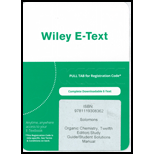
Concept explainers
Practice Problem 16.14
Dihydropyran reacts readily with an alcohol in the presence of a trace of anhydrous HCL or

(a) Write a plausible mechanism for this reaction.
(b) Tetrahydropyranyl ethers are stable in aqueous base but hydrolyze rapidly in aqueous acid to yield the original alcohol and another compound. Explain. (What is the other compound?)
(c) The tetrahydropyranyl group can be used as a protecting group for alcohols and phenols. Show how you might use it in a synthesis of 5-methyl-1,5-hexanediol starting with 4-chloro-1-butanol.
Want to see the full answer?
Check out a sample textbook solution
Chapter 16 Solutions
ORGANIC CHEMISTRY-ETEXT REG ACCESS
Additional Science Textbook Solutions
Basic Chemistry (5th Edition)
Chemistry: Structure and Properties (2nd Edition)
Chemistry: A Molecular Approach (4th Edition)
The Organic Chem Lab Survival Manual: A Student's Guide to Techniques
Chemistry & Chemical Reactivity
Organic Chemistry As a Second Language: Second Semester Topics
- Give the Grignard reagent and carbonyl compound or ethylene oxide that can be used to prepare the following alcohols. Show all pairs of possible combinations. (b) (CH₂)₂C(OH)CH₂CH₂CH₂ CH CH₂CH₂OHarrow_forward18.26 Predict the products of the following ether cleavage reactions: LOCH CH3 OC(CH3)3 (a) HI CF3CO,H, ? (b) H2O HI HI (c) Н,С— СНОСH,CH, (d) (CH3);CCH,OCH,CH3 H20 H2Oarrow_forward11:43 Q1. (a) (c) (d) (b) Two stereoisomers of but-2-ene are formed when 2-bromobutane reacts with ethanolic potassium hydroxide. (i) Explain what is meant by the term stereoisomers. Library Name and outline a mechanism for the reaction of 2-bromo-2-methylpropane with ethanolic potassium hydroxide to form the alkene 2-methylpropene, (CH3)2C=CH₂ Name of mechanism Mechanism (ii) Draw the structures and give the names of the two stereoisomers of but-2-ene. Stereoisomer 1 Name (iii) Name this type of stereoisomerism. Select Name Stereoisomer 2 When 2-bromo-2-methylpropane reacts with aqueous potassium hydroxide, 2-methylpropan-2-ol is formed as shown by the following equation. CH3 H₂C-C-CH3 + KOH Br Page 2 of 14 CH3 H3C-C-CH3 + KBr ОН State the role of the hydroxide ions in this reaction. Write an equation for the reaction that occurs when CH3CH₂CH₂CH₂Br reacts with an excess of ammonia. Name the organic product of this reaction. Equation Name of product 9,284 Photos, 1,166 Videos For You…arrow_forward
- Predict the major products formed when benzoyl chloride (PhCOCl) reacts with the following reagents.(a) ethanol (b) sodium acetate (c) anilinearrow_forwardAn unknown compound A of molecular formula C10H18O reacts with H2SO4 to form two compounds (B and C)of molecular formula C10H16. B and C both react with H2 in the presence of Pd-C to form decalin. Ozonolysis of B forms D, and ozonolysis of C forms a diketone E of molecular formula C10H16O2. Identify the structures of compounds A, B, C, and E.arrow_forwardRank the compounds in each of the following groups in order of their reactivity to electrophilic substitution: (a) Nitrobenzene, phenol, toluene, benzene (b) Phenol, benzene, chlorobenzene, benzoic acid (c) Benzene, bromobenzene, benzaldehyde, anilinearrow_forward
- Provide the reagents and solvents (where appropriate) needed to bring about the following transformations. (a) CI (b)arrow_forwardAttenol A and pinnatoxin A are natural products isolated from marine sources. (a) Locate the acetals, hemiacetals, imines, and enamines in both compounds. (b) Draw the hydrolysis product formed when attenol A is treated with aqueous acid. Include stereochemistry at all stereogenic centers.arrow_forwardRank the compounds in each group according to their reactivity towardelectrophilic substitution.(a) Chlorobenzene, o-dichlorobenzene, benzene(b) p-Bromonitrobenzene , nitrobenzene, phenol(c) Fluorobenzene, benzaldehyde, a-xylene(d) Benzonitrile, p-methylbenzonitr ile,p-methoxybenzonitrilearrow_forward
- (c) Arrange the following compounds in order of increasing acidity, and explain the reasons fo your choice of order: phenol, cyclohexanol, 2-fluorocyclohexanol, 2-fluoronhenolarrow_forwardExplain this observation: Ethyl 3-phenylpropanoate (C6H5CH2CH2CO2CH2CH3) reacts with electrophiles to afford ortho- and para-disubstituted arenes, but ethyl 3-phenylprop-2-enoate (C6H5CH=CHCO2CH2CH3) reacts with electrophiles to afford meta- disubstituted arenes.arrow_forwardPredict the major products formed when benzoyl chloride (PhCOCl) reacts with the following reagents.(a) ethanoarrow_forward
 Macroscale and Microscale Organic ExperimentsChemistryISBN:9781305577190Author:Kenneth L. Williamson, Katherine M. MastersPublisher:Brooks Cole
Macroscale and Microscale Organic ExperimentsChemistryISBN:9781305577190Author:Kenneth L. Williamson, Katherine M. MastersPublisher:Brooks Cole Organic ChemistryChemistryISBN:9781305580350Author:William H. Brown, Brent L. Iverson, Eric Anslyn, Christopher S. FootePublisher:Cengage Learning
Organic ChemistryChemistryISBN:9781305580350Author:William H. Brown, Brent L. Iverson, Eric Anslyn, Christopher S. FootePublisher:Cengage Learning

